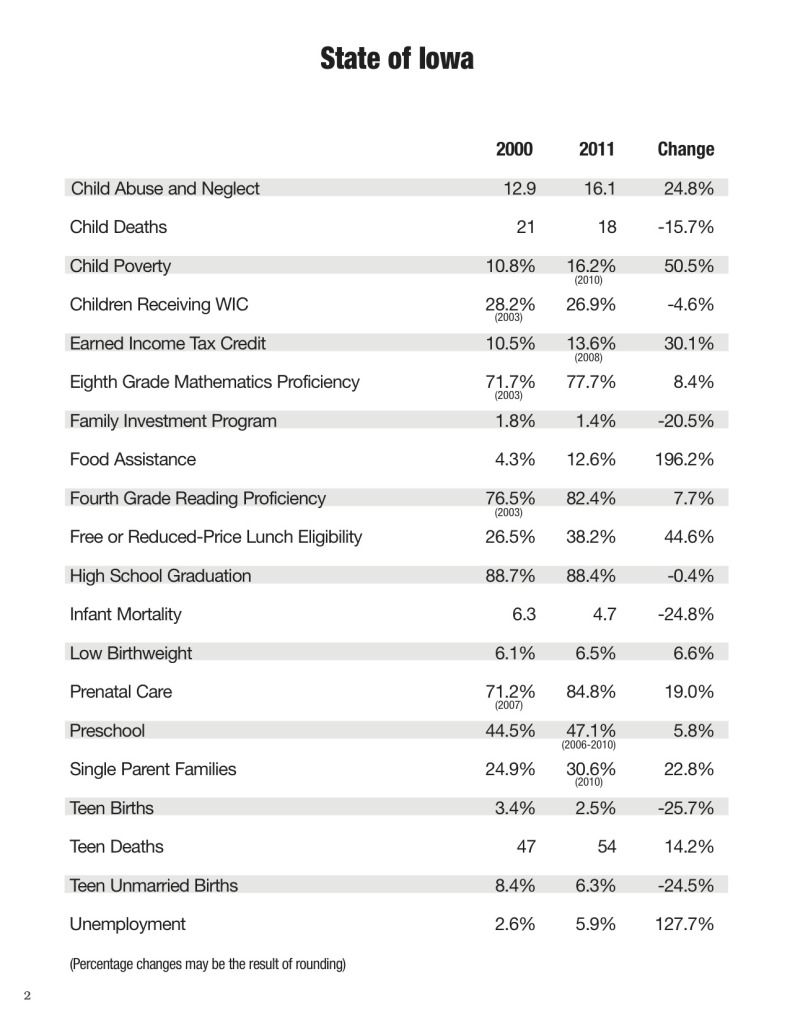As Iowa’s economy has improved this year, the unemployment rate has dropped slightly, and state tax revenues have increased. But a recent report on children’s well-being in Iowa shows that child poverty rose significantly over the past decade. Highlights from the “Iowa Kids Count 2011” report by the Des Moines-based Child & Family Policy Center are after the jump.
Governor Terry Branstad wants to use much of Iowa’s projected budget surplus for corporate tax cuts; he would also use part of the money to fund proposed changes to teacher pay. When state lawmakers consider how to use surplus funds, they should remember the Iowans most adversely affected by the “Great Recession,” who are least able to help themselves. The Child & Family Policy Center’s Every Child Counts project endorses specific legislative action that would improve the well-being of children and families. Those priorities are identical to policies advocated before the 2012 legislative session. Let’s hope lawmakers are paying more attention this year.
Child & Family Policy Center staff compile the Iowa Kids Count report every year, using county-level data on 20 indicators related to children’s health, educational achievement and economic circumstances. The full report is here (pdf), or you can jump straight to the table you’re interested in by clicking the links on this page. Tables for every indicator show statistics for all 99 Iowa counties, as well as statewide data and composite data for Iowa’s rural, small urban and metropolitan counties. “Rural” counties are those in which the largest town’s population is below 5,000. “Small urban” counties contain at least one town with a population between 5,000 and 50,000. Iowa’s nine “metropolitan” counties contain a city with a population greater than 50,000.
This chart summarizes the statewide numbers on each indicator of children’s health, education, or well-being.
Note that the percentage of children receiving help through the federal WIC program (Women with Infants and Children) declined from 2003 to 2011, even as child poverty rose by half statewide from 2000 to 2010, and the percentage of individuals getting some kind of food assistance nearly tripled from 2000 to 2011.
The percentage of children living in poverty has increased in all 99 counties since 2000. Statewide, the child poverty rate jumped from 10.8 percent in 2000 to 16.2 percent in 2010. In 24 counties, more than 20 percent of children were living in poverty as of 2010. The following counties had the highest percentages of children living in poverty in 2010:
Ringgold (29.5 percent)
Davis (27.8 percent)
Wayne (26.5 percent)
Decatur (26.2 percent)
Van Buren (26.0 percent)
Lucas (25.4 percent)
Black Hawk (25.2 percent)
Wapello (24.3 percent)
Appanoose (24.2 percent)
Des Moines (24.2 percent)
Lee (24.1 percent)
Jefferson (22.5 percent)
Floyd (22.4 percent)
Page (22.4 percent)
Allamakee (22.3 percent)
Montgomery (22.1 percent)
Webster (21.9 percent)
Woodbury (21.5 percent)
Union (20.9 percent)
Adams (20.7 percent)
Muscatine (20.4 percent)
Cass (20.4 percent)
Scott (20.2 percent)
Monona (20.0 percent)
In 21 counties, the percentage of children living in poverty increased by more than 60 percent between 2000 and 2010. The following counties had the highest rate of increase in the child poverty rate since 2000:
Jasper (112.2 percent)
Henry (95.1 percent)
Franklin (95.0 percent)
Black Hawk (92.4 percent)
Muscatine (79.0 percent)
Howard (78.3 percent)
Worth (77.4 percent)
Lee (70.9 percent)
Iowa (70.5 percent)
Cerro Gordo (70.0 percent)
Wright (66.4 percent)
Hamilton (66.3 percent)
Hancock (65.4 percent)
Allamakee (65.2 percent)
Winnebago (63.6 percent)
Story (62.5 percent)
Des Moines (62.4 percent)
Floyd (62.3 percent)
Clay (61.5 percent)
Linn (60.5 percent)
Winneshiek (60.0 percent)
In 85 of Iowa’s 99 counties, the percentage of children living in poverty increased by more than 30 percent between 2000 and 2010. The lowest rates of increase in child poverty were found in the following counties:
Sac (7.8 percent)
Kossuth (10.4 percent)
Palo Alto (15.1 percent)
Mitchell (15.6 percent)
Grundy (17.2 percent)
Guthrie (19.7 percent)
Taylor (18.9 percent)
Lyon (20.9 percent)
Audubon (20.4 percent)
Keokuk (23.8 percent)
Butler (24.5 percent)
Sioux (25.3 percent)
Louisa (27.1 percent)
Mills (28.7 percent)

